NEW ENGLAND ASTER
|
 |
| File Size: 81 KB |
|
|
|
Symphyotrichum novae-angliae (L. ) G.L. Nesom
|
| [=Aster novae-angliae L.] |
| Riley County, Kansas |
| Perennial |
| Height: 2-6 feet |
| Family: Asteraceae - Sunflower Family |
| Flowering Period: September,October |
|
| Stems: | | Clustered, rigidly erect, stout, much branched above, coarsely hairy. | | Leaves: | | Lower leaves shed early; main stem leaves alternate, numerous, simple, crowded, prominently clasping, lanceolate to oblong, 1 to 4 inches long, 1/2 to 1 inch wide, rough or stiff-hairy above, softer hairy below; margins entire; tips pointed. | | Inflorescences: | | Corymb-like clusters, spherical, terminal; heads 30-50, to 2 inches wide, on stalks covered with gland-tipped hairs; bracts narrowly linear, tips tapering, sharp-pointed, purplish green. | | Flowers: | | Ray florets 40-100, reddish purple to violet-purple; disk florets numerous, yellowish orange to reddish purple. | | Fruits: | | Achenes, silky hairy, tipped with reddish white, hair-like bristles, enclosing small seed. | | Habitat: | | Stream banks, wet meadows, thickets, low areas, and roadsides, most abundant in moist or drying sandy soils. | | Distribution: | | East third of Kansas. | | Uses: | | Native Americans used teas made from the roots of New England aster to treat fevers and diarrhea. | | Comments: | | New England aster is showy and often used in landscaping and flower gardens. The colorful blossoms attract butterflies and bees. |
|
| New England aster |  | | 88 KB | | Riley County, Kansas |
| | New England aster leaves |  | | 86 KB | | Wildcat Glades Conservation & Audubon Center, Newton County, Missouri |
| | New England aster leaf |  | | 57 KB | | Wildcat Glades Conservation & Audubon Center, Newton County, Missouri |
| | New England aster |  | | 127 KB | | Wildcat Glades Conservation & Audubon Center, Newton County, Missouri |
| | New England aster |  | | 53 KB | | Wildcat Glades Conservation & Audubon Center, Newton County, Missouri |
|
|
|
|
|
|
|